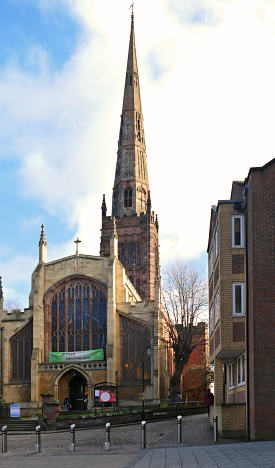|
Index...
|
After years of planning for, and objections against, an improved street layout to cope with the new phenomenon of the motor car, this street finally submitted to the bulldozer in 1936. Alderman C. Payne officiated at the closing ceremony on 1st January 1936, and despite many protests and alternative solutions being forwarded, Coventry City Council did what Coventry's Council had always done.... their own thing!
If only they had had the foresight to understand just how important these old streets would almost certainly have become to the rejuvenation of the town in these days of tourism. Treated sympathetically, I'm sure the Butcher and Ironmonger Rows, etc., would have attracted thousands of visitors anxious to revel in an historic past, just as they do nowadays at the few remaining unaltered places.
The first photo, looking northwards, was taken in 1900, and also shows the Bull Ring which occupied the bottom end of the lane. At the far end you could turn left into Ironmonger Row, or right into New Buildings - part of which still exists, with Nando's being a popular port of call. The building facing us at the far end of the street was the pub, the Golden Lion. Although the picture was taken over three decades before the street's demise, the council were already starting to draw up plans for street widening, which would spell the end for this central part of Coventry's medieval history. I can't imagine that anyone will ever speak of Trinity Street in the same affectionate terms that were used for Butcher Row.
Ironically, one of the stated reasons for the required change was traffic flow which, with the advent of the Inner Ring Road two decades after the war, became a redundant idea. Further changes made in 2012 prevented traffic between Trinity Street and Broadgate altogether. As the New Cathedral's architect Sir Basil Spence has also lamented, once a relic of the past has been destroyed, that particular light is extinguished forever, and cannot be re-lit.
|
There's no mystery about who took these two photos (!).... but neither is there any mystery to the modern day scenes. I wonder if the Coventrians who lived around those old streets in centuries gone by saw the same charm in their surroundings that we imagine existed when we look at those old photos?
|

|

|
Of course, it's quite feasible that these fragile timber framed buildings may not have survived the intense incendiary attacks of the Luftwaffe in 1940/41 anyway, but many did, and in fact, this area - now the east side of Trinity Street - was relatively lightly affected by the raids, but now we will never know for ourselves, will we?
The photo below shows Butcher Row looking southwards in the early 1900s. Clicking your mouse on it will fade forward in time to that same scene in 2024 - now the top end of Trinity Street, of course.

In the above photo, just before the black and white cottage on the left of the street is a narrow gap which is the entrance to Priory Row. If you walked up there and looked through the gap, the photo on the left shows what you would see.
Try this link to see the opposing view of Priory Row
On the right, of course, can clearly be seen the street sign indicating Little Butcher Row, as seen further up this page.
These two views of Butcher Row can more easily be put into perspective by taking a look at the two views of Trinity Lane on another page.
This atmospheric view of Priory Row first appeared in the guide book "Coventry - its Mediaeval Interest" around 1930.
Website by Rob Orland © 2002 to 2025